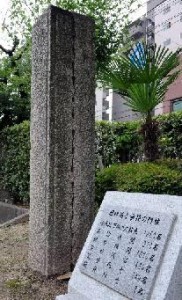My Life: Interview with Keiji Nakazawa, Author of “Barefoot Gen,” Part 3
Jul. 27, 2012
The day of the atomic bombing
by Rie Nii, Staff Writer
Escapes death by a whisker
On the morning of August 6, 1945, the sky over Hiroshima was wide and blue, no clouds in sight.
Shortly after 7 a.m., after I finished my breakfast, an air-raid siren sounded. But the warning was canceled so I headed to school. Kanzaki National School was located southwest of today’s Kanzaki Elementary School in downtown Hiroshima. It faced the streetcar tracks of the Eba Line, part of the Hiroshima Streetcar Company system. Just before I passed through the school gate, a mother of one of my classmates called out to me. I stopped and I was talking to her with my back against a concrete wall. I happened to look up at the sky and saw a B-29 bomber. “It’s a B-29,” we said. “But there’s been no siren.” Then, as the plane disappeared from view, the atomic bomb exploded.
Because I was standing there in the shade of the wall, I was able to survive the blast. I was grazed by the flash from an indirect angle, yet suffered burns behind my left ear, on the back of my head, and on the nape of my neck. The wall then came crashing down toward me, but a miracle occurred. A tree along the road, right in front of me, was blown over by the blast, but its trunk, about 40 centimeters from the root, still remained. I was positioned in the gap between the wall and the trunk, and that’s how I was saved from being crushed. The line between life and death right then was as thin as a razor’s edge. The woman I had been talking with was blown toward the streetcar tracks, her whole body burned black.
Mr. Nakazawa sought to go straight home.
It must have been a homing instinct. I found myself running home along the streetcar tracks. When I arrived at the alley leading to my house, that area had already turned into a sea of fire. My instinct told me it was dangerous, and I turned back. Then, for the first time since the blast, I felt emotion. I thought I was now all alone. I searched for my parents, crying, “Dad! Mom!” Luckily, a neighbor told me that my mother was at the Funairi Kawaguchi-cho streetcar stop.
Around me were a lot of people whose skin was drooping from their bodies. The skin was peeled from their shoulders to the backs of their hands, where it dangled from their fingernails. The skin from their backs hung from their buttocks like some kind of fabric wrapped around them. As they dragged the skin of their legs behind them, they were unable to lift their feet. A crowd of these people was approaching me.
When I finally reached that streetcar stop and looked toward the sidewalk on my left, I found my mother sitting blankly on a futon with a bundle of rags in her arms. I sank weakly to the ground beside her.
When I peered into the bundle that my mother was holding with such tenderness, I discovered a baby. My mother told me that she went into labor due to the shock of the bombing and gave birth on the street. A passerby helped her deliver the baby. We named the baby Tomoko, but she died of malnutrition four months later, because my mother was unable to produce milk.
(Originally published on July 5, 2012)








